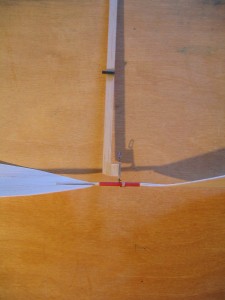My guiding principles for all things aeronautical is keep it simple and keep it light.
Here are a couple simple propeller and bearing assemblies that could be adapted for a Squirrel.
This is the propeller assembly for an EZ Penny. The propeller blades are 1/32″ sheet balsa, wet formed on the side of a 4″ peanut can. Putting them at a 15 degree angle to the axis of the can gives the blades a little twist. You can cut such blades directly from a plastic bottle. The root ends are slotted to take some 3/32″ square sticks. Those sticks are rounded on the inside ends to fit into a plastic or rolled paper tube. They are a tight friction fit, so their angle can be adjusted. The red hub has a short piece of hard balsa dowel in the center. The prop shaft is pushed through the bearing, then through a carefully centered pinhole in the center of the hub. The end is bent to a right angle, then glued and thread wrapped to the hub. A simpler hub could be made from a block of balsa with angled facets cut into the ends and the blades glued directly to the angled faces. The bearing is a short piece of aluminum tube, glued to a balsa spacer block. A shallow groove filed in the spacer block aligns the tube. There are a couple brass washers between the bearing and the hub. Glass beads also make good washers. You can make washers from the base of an aluminum can. It can be cut with scissors and drilled with a piece of wire cut on the diagonal to make a sharp point. To adapt this construction to a Squirrel, slant the bottom of the spacer block to point the prop shaft down about 5 degrees. You can bind the aluminum tube to the balsa with thread wrapping soaked with glue to hold it on better.
This is the propeller assembly on a Cloud Tramp. The propeller is carved from balsa. You can carve a propeller from a solid block having the same width, thickness and length as your propeller. This one was carved from a fan of 1/16″ x 3/8″ x 8″ balsa strips. The strips were laminated into a fan around a 1/32″ steel axle. When the prop was finished, the steel axle was twisted out and the prop shaft was pushed in place. The front end was bent back in a square U, point pulled back into the balsa and glued in place. The bearing is an L shaped piece cut and bent from a half round cotter pin. When I was a kid, we used to flatten finishing nails with a hammer and anvil for this purpose. I have heard of metal umbrella ribs being used for the purpose. A hole was drilled through the foot of the L. It was glued to the stick and wrapped with cotton string to hold it on. The prop hook is in the same plane as the prop, so it can be threaded through the hole. With the single hole bearing, the prop flails around when the motor goes slack, causing erratic descents. I added a 1/32″ steel wire pigtail. The prop hook threads through the helical pigtail. It does not sustain any significant load, it just keeps the prop shaft aligned with the stick. The prop may be removed and replaced. There are brass washers between the prop and the bearing. These methods may be adapted for a Squirrel. Use the Cotter pin, but bend both the ends up. Drill the front hole farther from the stick so the prop shaft makes a 5 degree angle with the stick. You can also bend up a wire bearing with a loop in front and a pigtail in the back. You must arrange a way to bind it firmly to the stick. This bearing goes on top of the Cloud Tramp. It goes underneath the sitck on the Squirrel.
Gary Hinze

